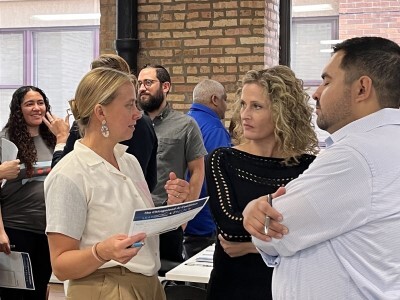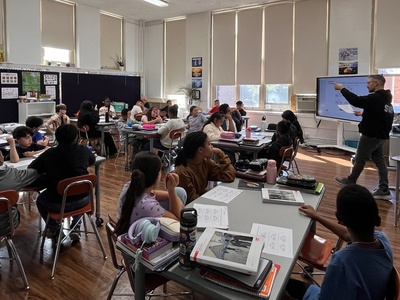Professional Learning
How Coaches Can Help Teachers Provide Deeper Learning Online
Topics

Educators are the lead learners in schools. If they are to enable powerful, authentic, deep learning among their students, they need to live that kind of learning and professional culture themselves. When everyone is part of that experiential through-line, that’s when next generation learning thrives.
COVID-19 has caused schools to question many assumptions. A teacher coach re-evaluates how coaching can help teachers focus on what really matters.
During my first year of teaching ten years ago, my students were working on a writing assignment when a group of six district officials and my principal entered the room, spread out around its periphery, and promptly turned away from the students to look at index cards taped to the wall. I’d had the idea to make a word wall for the school year which lined the outside of the room from A-Z; each word had its own index card with helpful information on the other side. Students could get up and flip a card over if they had forgotten something about a concept. This is hardly a ground-breaking idea, but the visitors were highly enthused. With murmurs of approval, nods, and a sly thumbs-up from my principal, the group left the room without asking a single student about their learning, or even looking at the activity in front of them./p>
COVID-19 has caused schools to question many assumptions. Teachers have shifted to online learning, causing growing pains for those who were not already implementing blended learning before the crisis. Many are also realizing that some of the features of effective distance instruction—instructional videos, blended learning modules, self-pacing, mastery-based grading, and student-driven projects—can be great for students even when schools reopen. As someone who coaches teachers as well, I realize that my role is also ripe for re-evaluation. We should ask ourselves if our coaching of teachers helps them focus on what really matters.
My “district walkthrough” story is emblematic of an approach to teacher coaching that values the appearance of order over instructional quality. While my classroom was functional that year, my instructional activities were middling at best, with too much rote learning and not enough inquiry. My school generally struggled with culture, though; as such, I can understand that my principal was happy to see a classroom that was “orderly.” Placing too much value on order, however, is not a recipe for deeper learning, and it can push teachers toward punitive classroom management systems that are particularly troubling when students are non-white, living in poverty, or both. We know that “disorderly behavior” stems from a combination of a student’s lived trauma, low investment in classroom activities, or lack of academic skills. Teacher coaching should focus on how to address these things directly, not paper over the cracks by creating a space in which students appear orderly.
In the pandemic, the mute button—or the absence of our most troubled students—can instantly create “order” in a virtual classroom, but we also know that this order tells us little about the quality of what students are actually learning. So what should teacher coaches emphasize to help teachers create classrooms that value learning, both online and in person?
- Focus on the quality of student-facing tasks. Remember that many students may only engage up to the level of thinking that a teacher expects. In the pandemic, I am spending time with teachers looking at how well their work is differentiated, how much critical thinking it requires, and how well it addresses multiple types of learners. That focus on the stuff the kids are looking at must remain once in-person school resumes. Coaching a teacher on how to subtly manage minor misbehavior while delivering live instruction is definitely helpful, but that behavior might not be a problem at all if kids’ work is engaging and accessible.
- Get on the same page about mastery-based grading. Ask your teachers: Do students know exactly how they will be graded, and to what extent is their grade based on mastery? Look at the rubrics your teachers are using and make sure that they value mastery of content over procedural compliance. Read student-facing documents together and ask: Will a student understand exactly what is required of them? The clearer the expectation of mastery is, the more likely a student is to achieve it.
- Differentiate coaching by need. At the start of the pandemic, I asked all the teachers I coach what they needed from me. Some want me to observe their online classes, some want me to look at their student-facing materials, and some want both. Their desires, coupled with my knowledge of their skill levels from having worked with them all year, inform how I coach them. The pandemic has made this flexibility necessary, but there is no reason not to operate this way normally. Some teachers do need coaching on building basic classroom culture to reach that baseline level of order that is necessary for instruction to begin, but not everyone. Teachers, like students, have different needs, and coaches have different strengths. Where possible, teacher needs should determine both teacher-coach pairings and the substance of coaching conversations.
- Dig in to teacher-student feedback. Right now, numerical grades and feedback on work are more important than ever, given that we can’t see our students in person. This frequency of feedback, though, is critical during the “normal” school year too. A classroom where students know they receive meaningful feedback every week will be both orderly and focused on learning; if teachers cannot give feedback to their students at least weekly, they need help managing their grading load. How often do admins actually sit down and help teachers plan out how they want to manage their grading workloads, to optimize their systems to get more high-quality feedback to students? If we invest time early in helping teachers develop efficient systems for feedback, both our teachers and their students will reap the rewards throughout their academic careers.
The pandemic has forced us to reconsider how we teach and coach teachers. Let’s all make sure we focus on what matters most: helping our teachers put high-quality tasks in front of students and giving them high-quality feedback that helps them grow.
Image at top via Unsplash




